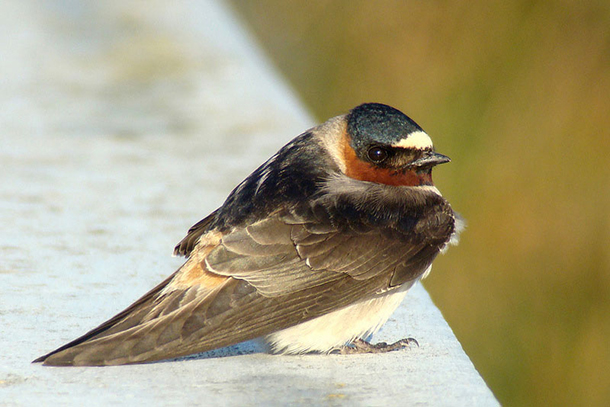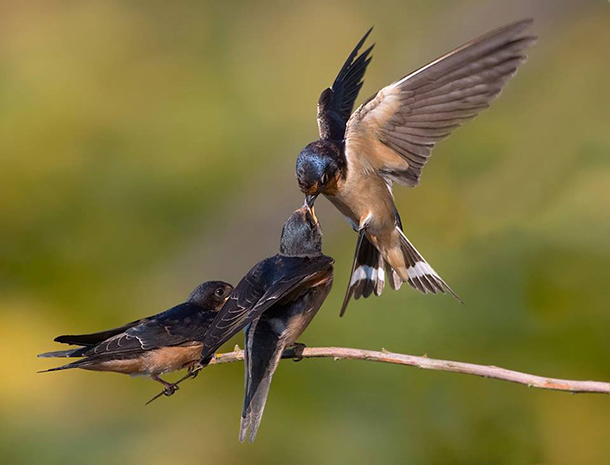BirdNote: Swallows in Winter
Air Date: Week of October 21, 2016

Cliff swallow (Photo: Maggie Smith)
Fall brings colorful leaves and departing swallows. As Michael Stein explains in today’s BirdNote, you’ll have to head down to Central and South America yourself if you want to hear their twittering over your head before next spring.
Transcript
[MUSIC: BIRDNOTE® THEME]
CURWOOD: The changing seasons bring special joys such as colorful leaves, and the luscious apples of autumn. But as Michael Stein points out in today's BirdNote®, there’s also a sense of loss when we bid farewell to one of the most beloved signs of summer.
BirdNote®
Where Swallows Go in Winter
[Calls of Barn Swallows]
Are any birds more conspicuous by their absence than swallows? Through all of spring and summer, swallows dart and sail overhead, their airborne grace a wonder to behold. [Continue Barn Swallows]
So while October marks a lovely juncture in the change of seasons, the skies seem empty. The swallows have flown south.
Swallows feed almost exclusively on flying insects, abundant in the warmer months, scarcer as fall takes hold. The swallows – eight species nest in the United States – must fly south for the winter, to latitudes where aerial insects are to be found.
[Song of Tree Swallow]
So, if you wanted to follow the swallows in winter, where would that journey take you? [Violet-green Swallow runs in background] Well, to catch up with Violet-green and Tree Swallows, you would traverse much of Central America. A search for the other six species would take you through much of South America. Indeed to see Cliff Swallows, you would have to strike off as far south as Argentina. [Calls of Cliff Swallow colony]

Feeding juvenile barn swallows (Photo: Tom Sanders)
For a parting look at swallow flocks in early October, visit the sort of places they concentrate before migrating. Check around large open fields or pastures, or wetlands like marshes or ponds – for a last chance to say farewell until next March or April.
[Continue Barn Swallows]
I’m Michael Stein.
###
Written by Bob Sundstrom
Bird audio provided by The Macaulay Library of Natural Sounds at the Cornell Lab of Ornithology, Ithaca, New York. Barn, Violet-green and Cliff Swallow recorded by G.A. Keller. Tree Swallow recorded by G.F. Budney.
Producer: John Kessler
Executive Producer: Chris Peterson
© 2005-2016 Tune In to Nature.org October 2016 Narrator: Michael Stein
http://birdnote.org/show/where-swallows-go-winter
CURWOOD: Swoop on over to our website, LOE.org for some pictures.
Links
The story on the BirdNote website, “Where Swallows Go in Winter”
More about Cliff Swallows on All About Birds from the Cornell Lab of Ornithology
More about the swallow family on All About Birds from the Cornell Lab of Ornithology
Living on Earth wants to hear from you!
Living on Earth
62 Calef Highway, Suite 212
Lee, NH 03861
Telephone: 617-287-4121
E-mail: comments@loe.org
Newsletter [Click here]
Donate to Living on Earth!
Living on Earth is an independent media program and relies entirely on contributions from listeners and institutions supporting public service. Please donate now to preserve an independent environmental voice.
NewsletterLiving on Earth offers a weekly delivery of the show's rundown to your mailbox. Sign up for our newsletter today!
 Sailors For The Sea: Be the change you want to sea.
Sailors For The Sea: Be the change you want to sea.
 The Grantham Foundation for the Protection of the Environment: Committed to protecting and improving the health of the global environment.
The Grantham Foundation for the Protection of the Environment: Committed to protecting and improving the health of the global environment.
 Contribute to Living on Earth and receive, as our gift to you, an archival print of one of Mark Seth Lender's extraordinary wildlife photographs. Follow the link to see Mark's current collection of photographs.
Contribute to Living on Earth and receive, as our gift to you, an archival print of one of Mark Seth Lender's extraordinary wildlife photographs. Follow the link to see Mark's current collection of photographs.
 Buy a signed copy of Mark Seth Lender's book Smeagull the Seagull & support Living on Earth
Buy a signed copy of Mark Seth Lender's book Smeagull the Seagull & support Living on Earth

